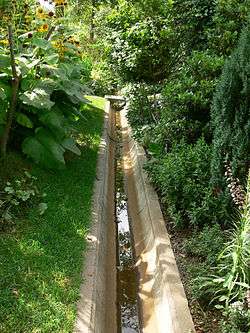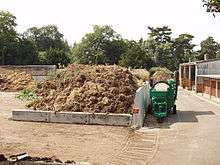Sustainable gardening

Sustainable gardening includes the more specific sustainable landscapes, sustainable landscape design, sustainable landscaping, sustainable landscape architecture, resulting in sustainable sites. It comprises a disparate group of horticultural interests that can share the aims and objectives associated with the international post-1980s sustainable development and sustainability programs developed to address the fact that humans are now using natural biophysical resources faster than they can be replenished by nature.[1]
Included within this compass are those home gardeners, and members of the landscape and nursery industries, and municipal authorities, that integrate environmental, social, and economic factors to create a more sustainable future.
Organic gardening and the use of native plants are integral to sustainable gardening.[2]
Historical development
After the establishment of sustainable agriculture in the early 1980s it was some time before the emergence of Sustainable Horticulture (as sustainable production horticulture) at the International Society of Horticultural Science's First International Symposium on Sustainability in Horticulture held at the International Horticultural Congress in Toronto in 2002. This symposium produced "conclusions ... on Sustainability in Horticulture and a Declaration for the 21st Century".[3] The principles and objectives outlined at this conference were discussed in more practical terms at the following conference at Seoul in 2006.[4]
Many of the eco-friendly principles and ideas espoused by sustainable gardens, landscapes and sites perpetuate sustainable practices established as a reaction to resource-intensive industrial agriculture. These practices were established as movements for self-sufficiency and small-scale farming based on a holistic systems approach and ecological principles. Included here would be: biodynamic agriculture, no-till farming, agroecology, Fukuoka farming, forest gardening, organic gardening and others. On a larger scale there is the more recent "whole farm planning"[5][6] which was established in 1995, and ecoagriculture[7][8] established in 2000, and other variants of sustainable agricultural systems. Perhaps the most influential of these approaches is permaculture, established by Australians Bill Mollison and David Holmgren as both a design system and a loosely defined philosophy or lifestyle ethic.[9] Permaculture shares many principles and practices of the above but not the broad philosophical base as indicated by the title of the 2002 publication Permaculture, principles and pathways beyond sustainability.[9] The application of sustainability principles to the horticultural sphere has now becoming broadly accepted in commerce and academia.
Definition
The American Sustainable Sites Initiative[10] is an interdisciplinary approach used by the American Society of Landscape Architects, the Lady Bird Johnson Wildflower Center and the United States Botanic Garden to create voluntary national guidelines and performance benchmarks for sustainable land design, construction and maintenance practices: it was founded in 2005. Using the United Nations Brundtland Report’s definition of sustainable development as a model, it defines sustainability within its own sphere of reference as:
… design, construction, operations and maintenance practices that meet the needs of the present without compromising the ability of future generations to meet their own needs
by attempting to:
...protect, restore and enhance the ability of landscapes to provide ecosystem services that benefit humans and other organisms.[11]
Principles and concepts
Managing global biophysical cycles and ecosystem services for the benefit of humans, other organisms and future generations has now become a global human responsibility.[12] The method of applying sustainability to gardens, landscapes and sites is still under development and varies somewhat according to the context under consideration. However, there are a number of basic and common underlying biological and operational principles and practices in the sustainable sites literature.
Biological principles
Sustainable management of man-made landscapes emulates the natural processes that sustain the biosphere and its ecosystems. First and foremost is the harnessing the energy of the Sun and the cycling of materials thereby minimising waste and energy use.
Running within, and dependent on, the natural economy there is the production and consumption of goods and services in the “human economy” which has now significantly altered, in a detrimental way, natural biogeochemical cycles (notable here are the water cycle, carbon cycle and nitrogen cycle so sustainable practices maximise support for ecosystem services.[1]
Native plants
The use of native plants in a garden or landscape can both preserve and protect natural ecosystems, and reduce the amount of care and energy required to maintain a healthy garden or landscape. Native plants are adapted to the local climate and geology, and often require less maintenance than exotic species. Native plants also support populations of native birds, insects, and other animals that they coevolved with, thus promoting a healthy community of organisms.[2]
Plants in a garden or maintained landscape often form a source population from which plants can colonize new areas. Avoiding the use of invasive species helps to prevent such plants from establishing new populations. Similarly, the use of native species can provide a valuable source to help these plants colonise new areas.
Some non-native species can form an ecological trap in which native species are lured into an environment that appears attractive but is poorly suited to them.
However, in Britain research by the University of Sheffield as part of the BUGS project (Biodiversity in Urban Gardens in Sheffield) has revealed that for many invertebrates - the majority of wild animals in most gardens - it is not just native plants which can sustain them. The findings were published in popular form in Ken Thompson's book 'No Nettles Required: The truth about wildlife gardening'. He confirms the approach which Chris Baines had promoted in 'How to Make a Wildlife Garden' .
Operational principles
Enhancement of ecosystem services is encouraged throughout the lifecycle of any site by providing clear design, construction, (operations), and management criteria.[10] To be sustainable over the long term requires environmental, social and economic demands are integrated to provide intergenerational equity by providing regenerative sustainable systems. Operational guidelines will link to and supplement existing guidelines for the built environment (supplementing existing green building and landscape guidelines),[10] the wider environment, and they will include metrics (benchmarks, audits, criteria, indexes etc.) that give some measure of sustainability (a rating system) by clarifying what is sustainable or not sustainable or, more likely, what is more or less sustainable.
Scale
Impacts of a site can be assessed and measured over any spatio-temporal scale or context.
Direct and indirect environmental impact
Impacts of a site may be direct by having direct measurable impacts on biodiversity and ecology at the site itself or indirect when impacts occur away from the site.
Site principles

The following are some site principles for sustainable gardening:[10]
- Do no harm
- Use the Precautionary principle
- Design with nature and culture
- Use a decision-making hierarchy of preservation, conservation, and regeneration
- Provide regenerative systems as intergenerational equity
- Support a living process
- Use a system thinking approach
- Use a collaborative and ethical approach
- Maintain integrity in leadership and research
- Foster environmental stewardship
Measuring site sustainability
One major feature distinguishing the approach of sustainable gardens, landscapes and sites from other similar enterprises is the quantification of site sustainability by establishing performance benchmarks. Because sustainability is such a broad and inclusive concept the environmental impacts of sites can be categorised in numerous ways depending on the purpose for which the figures are required. The process can include minimising negative environmental impacts and maximising positive impacts. As currently applied the environment is usually given priority over social and economic factors which may be added in or regarded as an inevitable and integral part of the management process. A home gardener is likely to use simpler metrics than a professional landscaper or ecologist.
Three methodologies for measuring site sustainability include BREEAM developed by the BRE organisation in the UK, Leed, developed in America and the Oxford 360 degree sustainability Index used in Oxford Park and developed by the Oxford Sustainable Group in Scandinavia.
The Sustainable Sites Initiative[13] is producing recommendations for the American Landscape Industry. The standards and guidelines finally adopted will lead to a uniform national standard, which does not currently exist. Sustainable Sites is currently in the pilot program stage, and will formally introduce its first rating system by 2013.[14] The U.S. Green Building Council supports the project and plans to adopt the Sustainable Sites metrics into future versions of its Leadership in Energy and Environmental Design Green Building Rating System. Sites are rated according to their impact on ecosystem services:[10] The following ecosystem services have been identified by the study group:
- Local climate regulation
- Air and water cleansing
- Water supply and regulation
- Erosion and sediment control
- Hazard mitigation
- Pollination
- Habitat functions
- Waste decomposition and treatment
- Global climate regulation
- Human health and well-being benefits
- Food and renewable non-food products
- Cultural benefits
|
INPUTS
|
OUTPUTS
|
PROCESSES |
Constraints
Any kind of auditing or benchmarking will depend on the selection and weighting of the metrics chosen; the depth and detail of analysis required; the purpose for which the figures are required; and the environmental circumstances of the particular site.
See also
- Permaculture
- Forest gardening
- Agroforestry
- Carbon cycle re-balancing
- Climate-friendly gardening
- Context theory
- Green roof
- Green transport
- Landscape planning
- Manure Tea
- Public Open Space (POS)
- Roof garden
- Sustainable design
- Sustainable landscaping
- Sustainable landscape architecture
- Sustainable planting
- Sustainable urban drainage systems
- Urban agriculture
- Urban forestry
- Urbanization
- Xeriscaping
References
- 1 2 Millennium Ecosystem Assessment (2005). Ecosystems and Human Well-being: Biodiversity Synthesis. Summary for Decision-makers. pp.1-16. Washington, DC.: World Resources Institute. The full range of reports is available on the Millennium Ecosystem Assessment web site. . Retrieved on: 2009-03-16
- 1 2 "Sustainable Gardening: The New Generation of Eco-Friendly Gardening!", Cornucopia Network of New Jersey, Inc. Newsletter, Spring (April) 2009.
- ↑ Bertschinger, L. et al. (eds) (2004). Conclusions from the 1st Symposium on Sustainability in Horticulture and a Declaration for the 21st Century. In: Proc. XXVI IHC – Sustainability of Horticultural Systems. Acta Hort. 638, ISHS, pp. 509-512. Retrieved on: 2009-03-16.
- ↑ Lal, R. (2008). Sustainable Horticulture and Resource Management. In: Proc. XXVII IHC-S11 Sustainability through Integrated and Organic Horticulture. Eds.-in-Chief: R.K. Prange and S.D. Bishop. Acta Hort.767, ISHS, pp. 19-44.
- ↑ Outline of the Whole Farm Planning philosophy and application. Retrieved on: 2009-03-16.
- ↑ Binns, R. M & Petheram, R. J. (1995). Whole farm planning. Victoria. Longerenong College, Faculty of Agriculture, Forestry and Horticulture, the University of Melbourne. Retrieved on: 2009-03-16.
- ↑ McNeely, J.A. & Scherr, S.J. (2003). Ecoagriculture: strategies to feed the world and save wild biodiversity. Island Press, London.
- ↑ ISBN 1-86285-753-9. An explanation of the eco-agriculture movement aims and objectives since its inception in 2000 when the term "ecoagriculture" was coined. Includes bibliographical references. Retrieved on:2009-03-16.
- 1 2 Holmgren, D. (2002). Permaculture, principles and pathways beyond sustainability. Holmgren Design Services, Hepburn, Australia. ISBN 0-646-41844-0
- 1 2 3 4 5 American Society of Landscape Architects, Lady Bird Johnson Wildflower Center, University of Texas at Austin United States Botanic Garden. The sustainable sites initiative. Guidelines and performance benchmarks. The sustainable sites initiative. Retrieved on: 2009-03-16.
- ↑ The Sustainable Sites Initiative. American Society of Landscape Architects, Lady Bird Johnson Wildflower Center, University of Texas at Austin United States Botanic Garden. pg. 6.
- ↑ United Nations. 1987."Report of the World Commission on Environment and Development." General Assembly Resolution 42/187, 11 December 1987. Retrieved: 2009-03-03
- ↑ "Sustainable Sites Initiative". Sustainablesites.org. Retrieved 2012-03-10.
- ↑ "Sustainable Sites FAQs". Retrieved 7 April 2011.
External links
- Information on designing a sustainable urban landscape
- Sustainable Environmental Design and Landscape Stewardship


